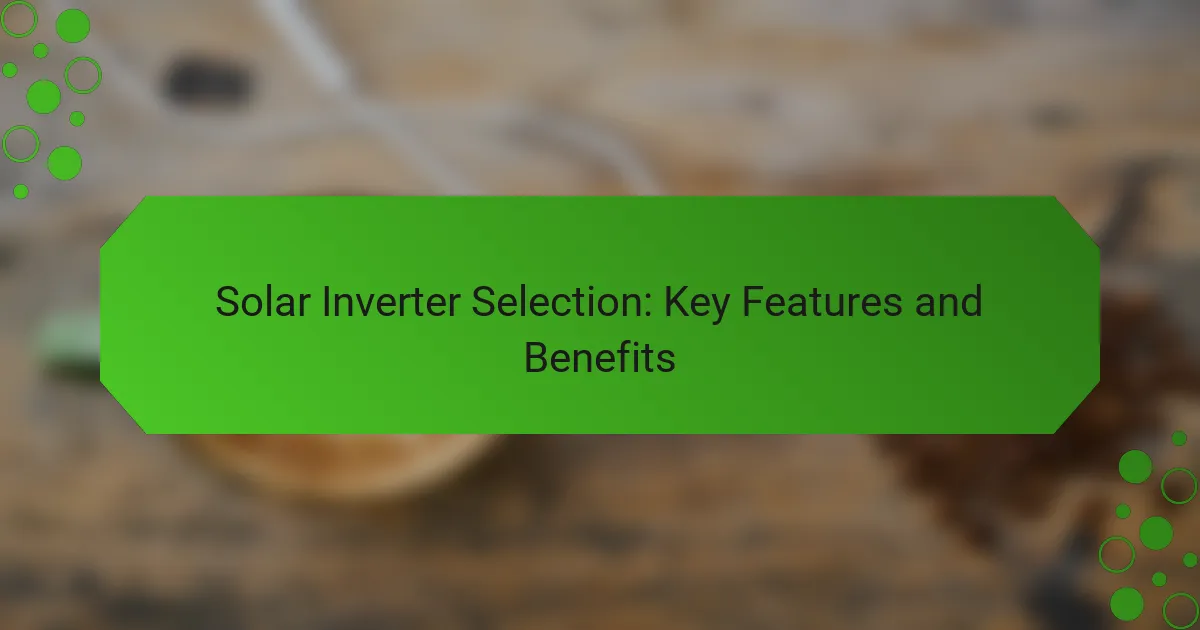Solar inverters play a vital role in solar power systems by converting the direct current (DC) from solar panels into alternating current (AC) for everyday use. When selecting a solar inverter, it’s important to consider factors such as efficiency, grid compatibility, and monitoring capabilities to ensure optimal performance and energy savings. A well-chosen inverter not only maximizes energy conversion but also enhances the overall efficiency of your solar installation.
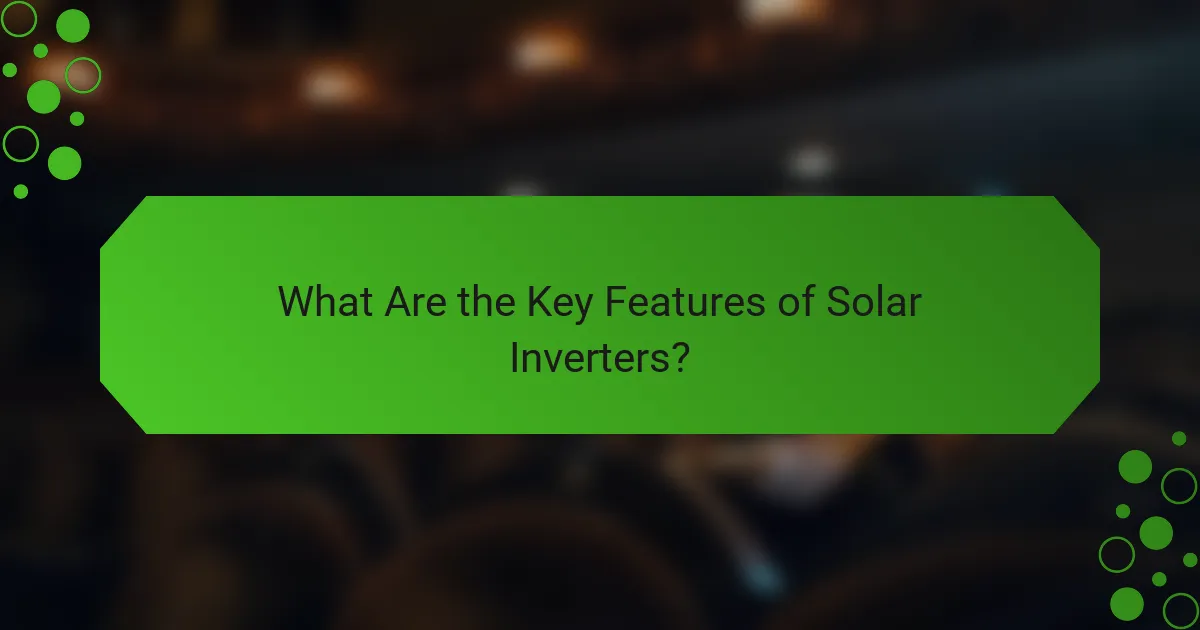
What Are the Key Features of Solar Inverters?
Solar inverters are essential components of solar power systems, converting direct current (DC) generated by solar panels into alternating current (AC) for use in homes and businesses. Key features to consider include efficiency ratings, grid compatibility, durability, monitoring capabilities, and installation requirements.
Efficiency ratings
Efficiency ratings indicate how effectively a solar inverter converts DC to AC power. Most modern inverters have efficiency ratings between 95% and 98%, meaning they lose only a small percentage of energy during conversion. Higher efficiency can lead to greater energy savings over time.
When selecting an inverter, look for models that meet or exceed the minimum efficiency standards set by organizations like the California Energy Commission (CEC). This ensures optimal performance and long-term reliability.
Grid compatibility
Grid compatibility is crucial for ensuring that your solar inverter can connect to the local electricity grid. In many regions, inverters must comply with specific grid standards, such as IEEE 1547 in the United States or G83/G59 in the UK. These standards help maintain grid stability and safety.
Before purchasing, verify that the inverter is compatible with your local utility’s requirements. This may involve checking for certifications or consulting with your installer to avoid potential issues during installation.
Durability and warranty
Durability is a key feature of solar inverters, as they must withstand various environmental conditions. Look for inverters with robust enclosures that protect against dust, moisture, and temperature fluctuations. Many manufacturers offer warranties ranging from 5 to 12 years, which can indicate the expected lifespan of the product.
Choosing an inverter with a longer warranty can provide peace of mind and potentially save on replacement costs. Always review the warranty terms to understand what is covered and any conditions that may apply.
Monitoring capabilities
Monitoring capabilities allow users to track the performance of their solar power system in real-time. Many modern inverters come with built-in monitoring features or can connect to external monitoring systems via Wi-Fi or cellular networks. This enables users to view energy production, consumption, and system health.
Consider inverters that offer user-friendly apps or web interfaces for easy access to performance data. This can help identify issues quickly and optimize energy usage, leading to increased savings.
Size and installation requirements
The size and installation requirements of solar inverters can vary significantly based on the system’s capacity and design. Inverters are typically rated by their power output, measured in kilowatts (kW). Ensure that the inverter’s capacity matches or slightly exceeds the total output of your solar panels.
Installation considerations include space for mounting, ventilation, and accessibility for maintenance. Consult with a professional installer to determine the best location and setup for your specific solar system, ensuring compliance with local codes and regulations.
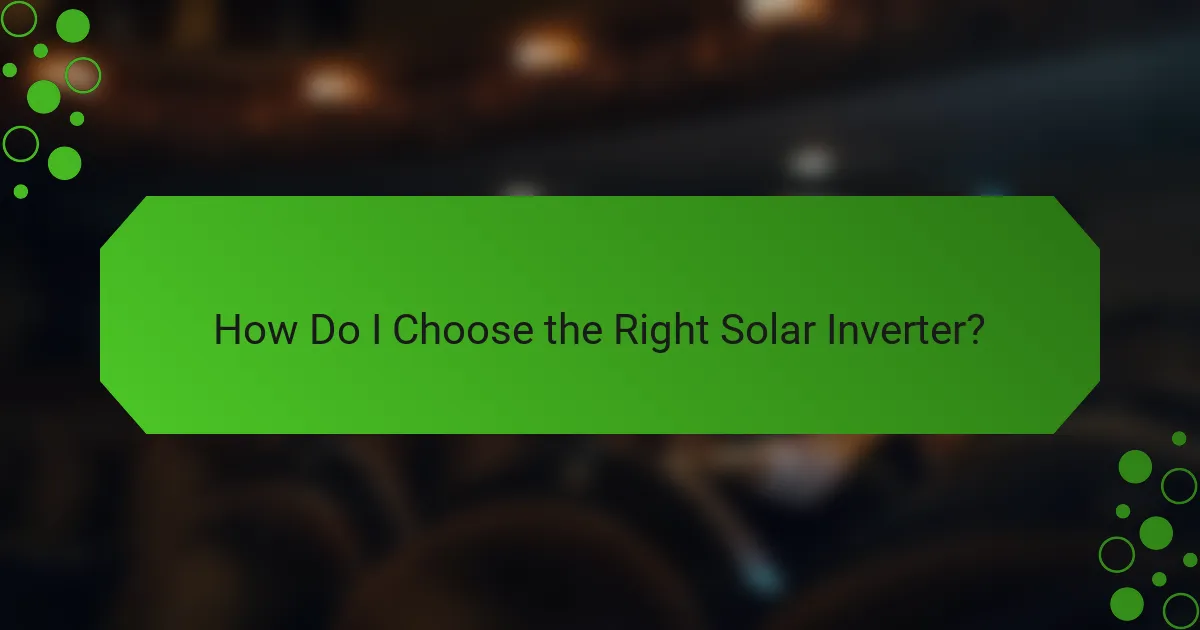
How Do I Choose the Right Solar Inverter?
Choosing the right solar inverter involves understanding your energy needs, evaluating different inverter types, and comparing reputable brands. A well-selected inverter optimizes energy conversion and enhances the overall efficiency of your solar power system.
Assessing energy needs
Start by determining your household’s energy consumption, typically measured in kilowatt-hours (kWh). Review past electricity bills to find your average monthly usage, which can range from a few hundred to several thousand kWh depending on your lifestyle and home size.
Consider future energy needs as well, such as potential electric vehicle charging or home expansions. This foresight helps in selecting an inverter that can handle increased loads without compromising performance.
Evaluating inverter types
There are primarily three types of solar inverters: string inverters, microinverters, and power optimizers. String inverters are cost-effective for most residential setups, while microinverters offer better performance in shaded areas by optimizing energy production at the panel level.
Power optimizers combine features of both, allowing for panel-level optimization while still using a string inverter. Assess your roof’s layout and shading conditions to decide which inverter type will best suit your installation.
Comparing brands like SMA and Fronius
When comparing brands like SMA and Fronius, consider factors such as efficiency ratings, warranty periods, and customer support. SMA is known for its reliable performance and extensive service network, while Fronius offers innovative features and high efficiency.
Look for user reviews and professional ratings to gauge real-world performance. Both brands typically provide warranties ranging from 5 to 10 years, so evaluate the terms to ensure long-term reliability and support for your investment.
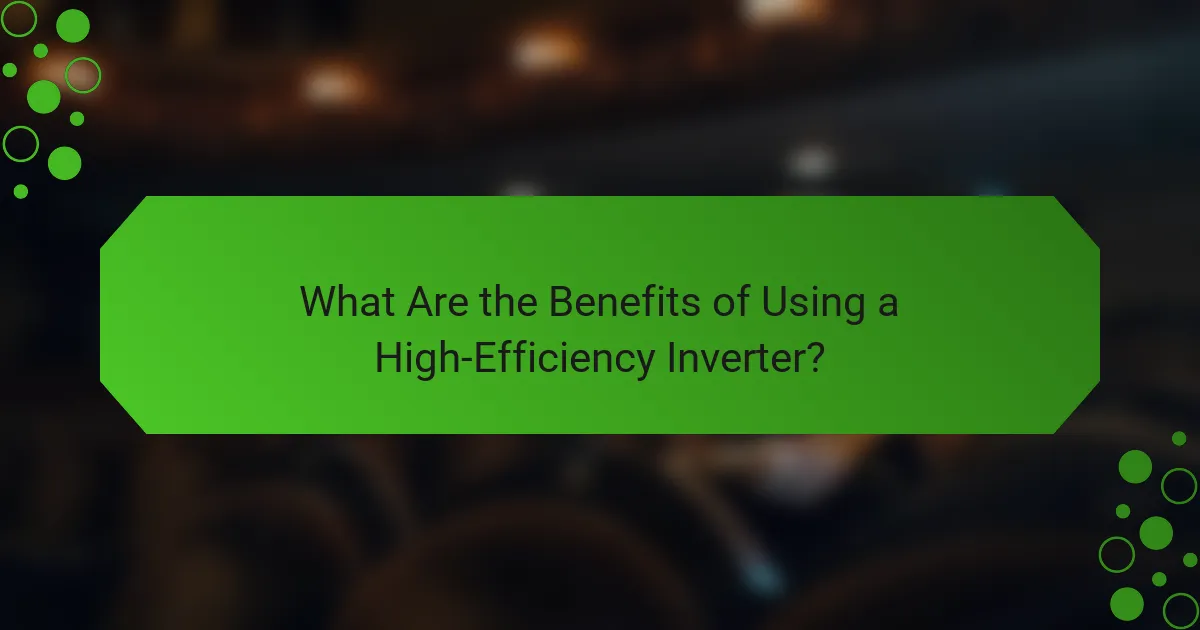
What Are the Benefits of Using a High-Efficiency Inverter?
A high-efficiency inverter maximizes energy conversion from solar panels, leading to greater energy output and cost savings. By optimizing the use of solar energy, these inverters enhance overall system performance, making them a crucial component for any solar installation.
Increased energy output
High-efficiency inverters convert a larger percentage of the energy generated by solar panels into usable electricity. This means that for the same amount of sunlight, you can expect to generate more power compared to standard inverters. In practical terms, this can translate to several hundred additional kilowatt-hours per year, depending on your system size and location.
Choosing an inverter with a conversion efficiency of 95% or higher can significantly boost your overall energy production. This is especially beneficial in regions with high solar irradiance, where maximizing output is essential for optimizing return on investment.
Long-term cost savings
Investing in a high-efficiency inverter can lead to substantial long-term savings on energy bills. By producing more electricity, you can reduce your reliance on grid power, which can be particularly advantageous in areas with high electricity rates. Over time, these savings can offset the initial higher cost of the inverter.
Additionally, many high-efficiency inverters come with longer warranties, often ranging from 10 to 25 years. This not only provides peace of mind but also reduces the likelihood of costly replacements or repairs in the future.
Improved system performance
High-efficiency inverters often include advanced features such as maximum power point tracking (MPPT), which optimizes energy harvest from solar panels. This technology adjusts the inverter’s operation to ensure it consistently extracts the maximum possible power, even under varying sunlight conditions.
Moreover, these inverters typically offer better thermal management and reliability, which can enhance the overall performance of your solar system. By minimizing energy losses and improving operational stability, high-efficiency inverters contribute to a more effective and durable solar energy solution.
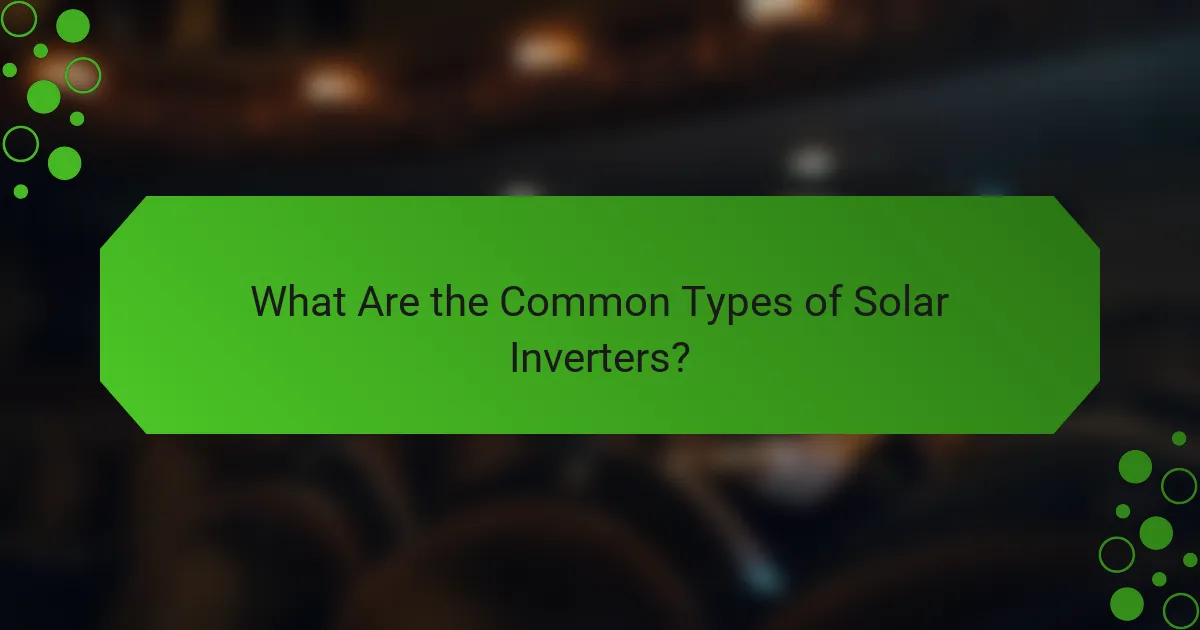
What Are the Common Types of Solar Inverters?
The common types of solar inverters include string inverters, microinverters, and power optimizers. Each type has unique features and benefits that cater to different solar panel setups and energy needs.
String inverters
String inverters are the most widely used type of solar inverter, connecting multiple solar panels in a series or “string.” They are typically cost-effective and easy to install, making them a popular choice for residential systems.
However, their performance can be affected by shading or panel mismatches, as the entire string operates at the level of the weakest panel. For optimal performance, ensure that all panels in a string receive similar sunlight exposure.
Microinverters
Microinverters operate on a per-panel basis, converting solar energy to electricity at each individual panel. This design allows for improved energy production, especially in partially shaded conditions, as each panel can perform independently.
While microinverters tend to be more expensive than string inverters, their enhanced efficiency can lead to higher overall energy yields, making them a worthwhile investment for some homeowners.
Power optimizers
Power optimizers are similar to microinverters but work in conjunction with a string inverter. They are installed on each solar panel to maximize energy output by mitigating the effects of shading and panel mismatch.
This hybrid approach combines the cost-effectiveness of string inverters with the performance benefits of microinverters, making power optimizers a flexible option for various solar installations.
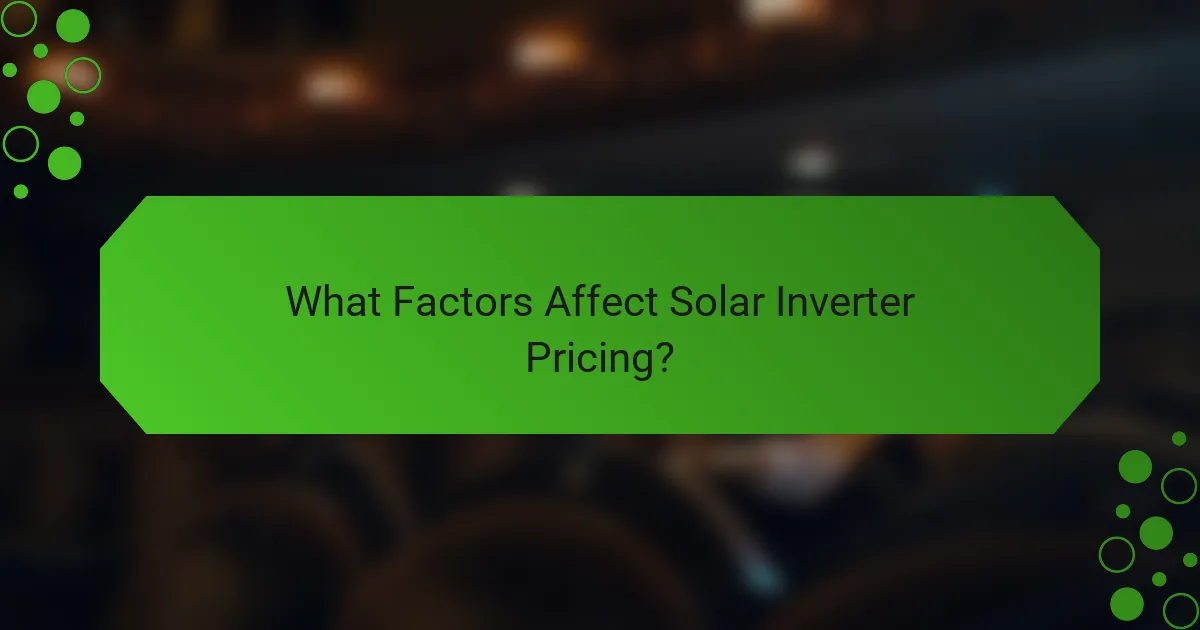
What Factors Affect Solar Inverter Pricing?
Solar inverter pricing is influenced by several key factors, including brand reputation, features and specifications, and installation costs. Understanding these elements can help you make informed decisions when selecting an inverter for your solar energy system.
Brand reputation
The brand reputation of a solar inverter can significantly impact its pricing. Well-established brands often command higher prices due to their proven reliability and customer service. Investing in a reputable brand may offer peace of mind and better warranty options.
When evaluating brands, consider customer reviews and industry certifications. Brands with positive feedback and certifications from organizations like UL or IEC tend to provide higher quality products, which can justify their premium pricing.
Features and specifications
The features and specifications of a solar inverter play a crucial role in determining its cost. Inverters with advanced functionalities, such as monitoring capabilities, higher efficiency ratings, and compatibility with smart home systems, typically come at a higher price point.
For example, string inverters are generally less expensive than microinverters, but they may not offer the same level of performance in shaded conditions. Assess your specific needs and the features that will benefit your solar setup to find the best value.
Installation costs
Installation costs can vary widely based on the complexity of the solar system and the inverter type. Factors such as labor rates, local regulations, and the need for additional equipment can all influence the total installation price.
On average, installation costs can range from a few hundred to several thousand dollars. It’s advisable to obtain multiple quotes from licensed installers to ensure competitive pricing and to understand what is included in the installation package.
